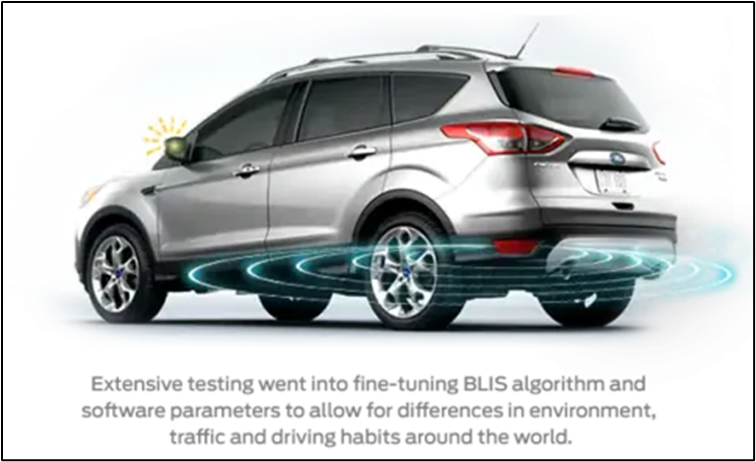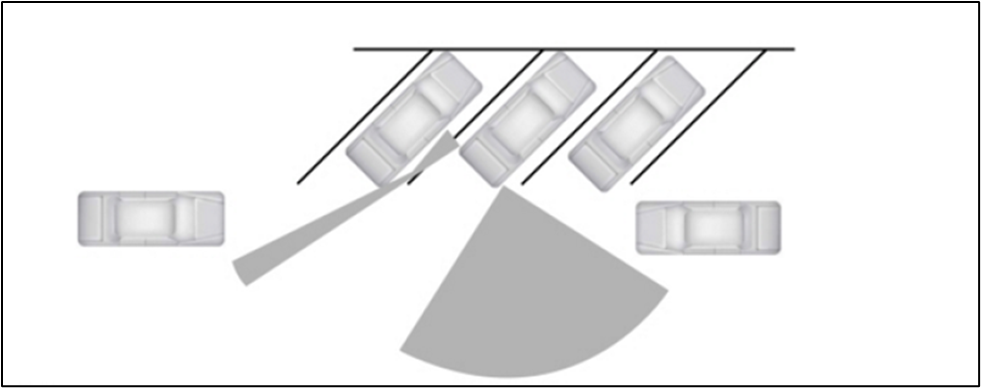What is the Blind Spot Information System (BLIS®)?
No car design has ever been able to totally eliminate them. So we’ve given you the next best thing. Another ‘set of eyes’ that looks out for vehicles you may not see at first glance when changing lanes.
This video explains how the innovative Blind Spot Information System (BLIS®) with Cross Traffic Alert works to help avoid accidents by detecting other vehicles in your blind spot when changing lanes or backing up.*
*Overseas Model Shown
Please be advised that fordowner.com is not available in the Philippines.

The Blind Spot Information System (BLIS) is designed to aid in detecting vehicles that may have entered the blind spot zone, which is represented by the vehicles in position A of the diagram below. The detection area is on both sides of your vehicle, extending rearward from the exterior mirrors to approximately 4.5M beyond the bumper. The system is designed to alert you if certain moving vehicles enter the blind spot zone while driving.
The basic rear radar range required by ISO standards is three meters. But after extensive test driving with customers, we found that the perception was that cars ‘felt’ too close when the light appeared in the side mirror. A range of 4.5 meters created a greater sense of comfort.
Note: To help avoid injuries, never use BLIS as a replacement for checking the interior and exterior mirrors and looking over your shoulder before changing lanes. BLIS is not a replacement for careful driving.
Never use the Cross Traffic Alert system as a replacement for checking the interior and exterior mirrors and looking over your shoulder before slowly backing out of a parking space. Cross Traffic Alert is not a replacement for careful driving.
Note: BLIS will not detect parked vehicles, people, animals, or infrastructure (fences, guardrails, trees, etc.). It is only designed to help alert you to moving motor vehicles in the blind zones. BLIS and Cross Traffic Alert will not be triggered if a vehicle passes through the blind zone in under two seconds.
Using the Systems
Using BLIS
BLIS will turn on when you start the engine and begin driving forward above 5 km/h. It will remain on as long as the transmission is in drive (D) or neutral (N). If you shift into reverse (R), BLIS will deactivate and the system will enter Cross Traffic Alert mode. BLIS will reactivate once you shift back into drive and begin driving forward above 5 km/h. BLIS does not function in reverse (R) or park (P). Using the turn signal will not cause BLIS to provide any additional warning (radars can only detect vehicles, not pedestrians or other objects).

Using Cross Traffic Alert
Cross Traffic Alert is designed to detect approaching vehicles from up to 14 meters away, though coverage decreases when the sensors are obstructed. Reversing slowly helps increase the effectiveness and coverage area of the system. For manual transmission vehicles, Cross Traffic Alert will be active only if the transmission is in reverse (R). If your vehicle is rolling backward and the transmission is not in reverse (R), Cross Traffic Alert will not be active.
Cross Traffic Alert Coverage Zones
In this first Cross Traffic Alert example, the left sensor is only partially obstructed by a parked vehicle, and zone coverage is nearly maximized.

In this second Cross Traffic Alert example, parking at shallow angles limits zone coverage. The left sensor is mostly obstructed by a parked vehicle, which severely limits zone coverage on that side.

System Lights and Messages
When either BLIS or Cross Traffic Alert is triggered, both systems will illuminate a yellow alert indicator on the outside mirror on the same side as the approaching vehicle. This alert indicator will dim when the system detects nighttime darkness.
Cross Traffic Alert will also sound a series of tones and trigger a message in the information display to indicate that a vehicle is approaching on your right or left. Cross Traffic Alert works in tandem with the reverse sensing system, which sounds its own series of tones.
System Sensors
Sensor Obstructions and System Errors
BLIS and Cross Traffic Alert use radar sensors, which are located behind the rear bumper fascia on each side of your vehicle. Ensure that these areas are clear of mud, snow, and bumper stickers since these obstructions can cause degraded performance.
If the system detects degraded performance, a message will warn you of a blocked sensor, or a low visibility message will appear in the information display along with a warning indicator. You can clear the information display warning, but the warning indicator will remain illuminated.
WARNING: In the event that a BLIS sensor becomes obstructed, there may be an interval during which the system is unable to detect objects before alerting the driver to the malfunction. Never use BLIS as a replacement for checking the interior and exterior mirrors and looking over your shoulder before changing lanes. BLIS is not a replacement for careful driving.
After removing a blockage:
Cycle the ignition from on to off and then back on.
Ensure that the system detects at least two vehicles while driving.
If the blockage is still present after cycling the ignition and driving in traffic, check again for a blockage. If either system senses a problem with the left or right sensor for any other reason, the Blind Spot Information System warning indicator will illuminate and a message will appear in the information display. All other system faults will display only with a message in the information display.
Warning Message Triggers
| Condition | Action |
| The radar sensor surface is dirty or obstructed. | Clean the fascia area in front of the radar sensor or remove the obstruction. |
| The radar surface is not dirty or obstructed. | Drive normally in traffic for a few minutes to allow the radar to detect passing vehicles and clear the blocked state. |
| Heavy rainfall or snowfall is interfering with the sensor radar signals. | No action required. The system will automatically reset to an unblocked state once rainfall or snowfall decreases or stops. Do not use BLIS or Cross Traffic Alert in these conditions. |
System Limitations
The Blind Spot Information and Cross Traffic Alert systems do have their limitations. Conditions such as severe weather or debris buildup on the sensor areas may limit vehicle detection.
Other situations that may limit BLIS detection include:
Certain maneuvers of other vehicles as they enter and exit the blind zone.
Vehicles passing through the blind zone at very fast rates.
Several vehicles forming a convoy and passing through the blind zone.
Other situations that may limit the Cross Traffic Alert system include:
Adjacently parked vehicles or objects obstructing the sensors.
Approaching vehicles passing at speeds greater than 24 km/h.
Driving in reverse faster than 5 km/h.
Backing out of an angled parking spot.
False Alerts
It is possible that BLIS or Cross Traffic Alert will trigger an alert even though there is no vehicle in the blind zone. Occasional false alerts are normal and will either self-correct or clear after cycling the ignition from on to off and then back on.
If your vehicle has a factory-equipped tow bar and it is towing a trailer, the sensors will detect the trailer and turn the Blind Spot Information and Cross Traffic Alert systems off to avoid false alerts. For non-factory equipped tow bars, you may want to manually turn off BLIS.
Switching the Systems Off and On
You can temporarily switch off one or both systems by using the information display. See General Information for details. When you switch off the Blind Spot Information System, you will not receive alerts and the information display will show a system off message. The Cross Traffic Alert system always switches on whenever the ignition is switched on. However, the Blind Spot Information System will remember the last selected on or off setting. Neither system can be switched off when MyKey is used.
You can have one or both systems switched off permanently at an authorized . Once switched off, the system can only be switched back on at an authorized Dealer.
For specific information on your vehicle, select the vehicle model from the Owner’s Manual Information for you further information.